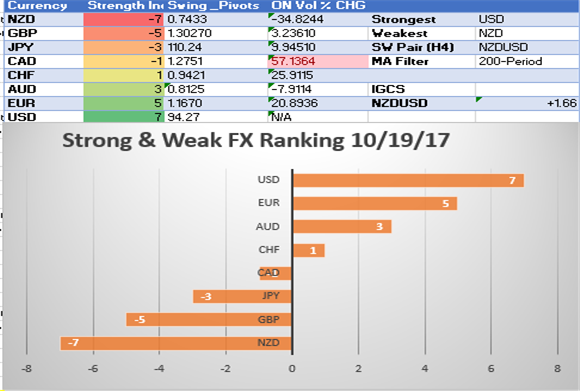Strong Weak Analysis is a way to identify momentum in the FX market. Trend traders rely on spotting and riding momentum as it develops and looks to benefit from trends extending, as many do. It’s also worth noting when the strength of a trend is waning, which Strong Weak analysis can also benefit.
Each day will bring you an index of strong and weak currencies as identified via the methodology in our article, ‘How to Create a “Trading Edge”: Know the Strong and the Weak Currencies.’ I will also share with you sentiment developments via IG Client Sentiment that can provide additional insight to help you decide what trends could extend.
A new column has been added to help explain the overnight at the money implied volatility per options. The model below is looking at % change from one day to a next, and a higher number favors higher expected volatility in the near future. Implied volatility regardless of tenor is a measure of the market’s priced in or expected future volatility of a currency. Our focus here is over the next 24-hours.
Strong/ Weak Index October 19, 2017

Chart created by Tyler Yell, CMT
Highlights:
-The New Zealand Dollar may be on the cusp of a new currency regime. There are more questions than answers, but the 2% drop should help you communicate that the NZD is no longer a likely contender for dip-buying. Overnight, Winston Peters of NZ First announced that his party would back the opposition and not the incumbent party. The coalition is expected to make the 37-year old Jacinda Ardern the new PM. The platform has argued for full employment, limiting immigration, and understanding that “[NZ] start to return to an economy that realizes that we live or die by exports.” That is one of the more dovish comments I’ve heard from a government since Abe introduced Abenomics in 2012.
– The Canadian Dollar does not have a clear position on the strong/ weak scale, but it easily could over the next seven days. A week from today, traders will have a clear understanding of Canadian inflation given Friday’s CPI print and the Bank of Canada’s outlook for rate hikes. The expectation of a hike at the October 25 meeting has declined from over 50% in mid-September to now around 21%. There is currently a 47% probability of a BoC rate hike in early October. Any significant change to that probability will lend to a likely move toward the top or bottom of the SW model.











Leave A Comment